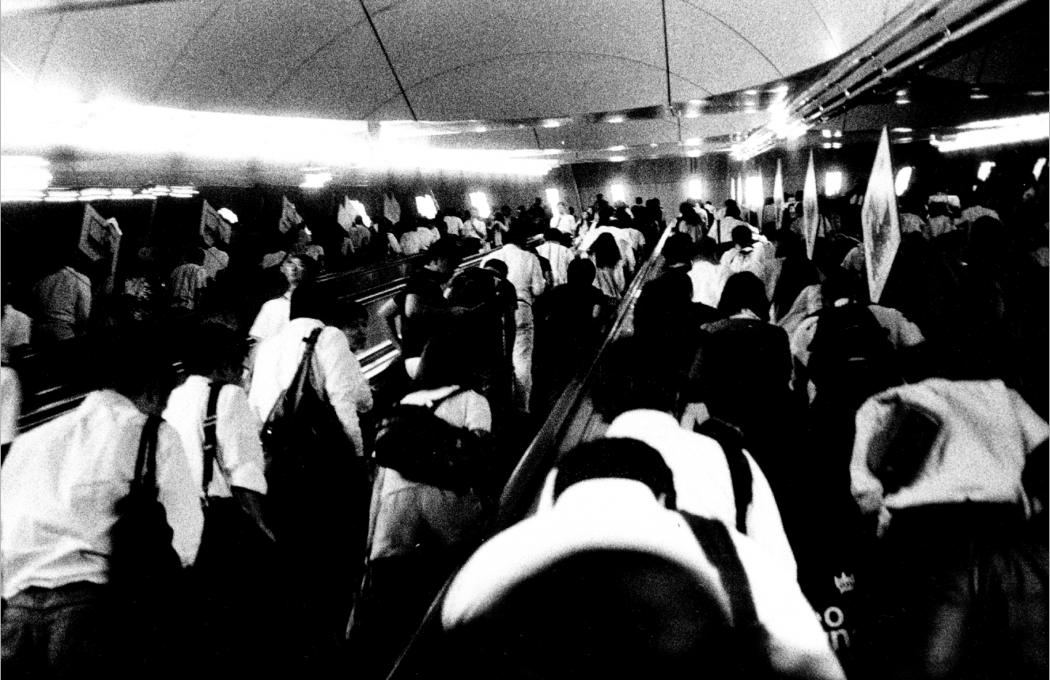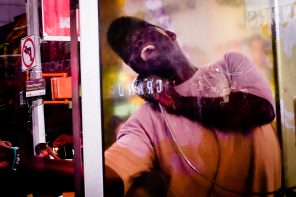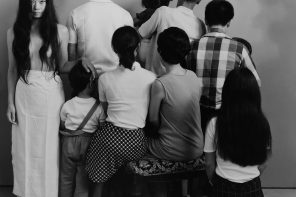I wasn’t anywhere close to Japan when Daido Moriyama’s first book, “A Photo Theater,” dropped in 1968, but I like to think its effect on the Japanese photography world was like the Beatles’ “I Want to Hold Your Hand” hitting America four years earlier. As in, “What was that? Wow, everything is different now—and always will be.”
A few years later came the Provoke books, Daido participating from the second one on, and, yes, everything in Japanese photography was different. Soon the high-contrast, murkily focused photos would spread to the world and things would be different there, too, though hardly as much as one might have thought, that grainy, rough, blurry aesthetic never quite upsetting the use-the-right-focal-length, keep-it-sharp expectations of Western photography. I’m sure you can hear the words in your own ears now: “That photo’s no good, it’s not in focus.” Oh, yeah. Sure.
But many photographers remain inspired by Daido, his past revolutionary work and his present day marvels, from a late classic like “Pretty Woman” (2017) to his endless parade of “Records.” Two photographers clearly under his sway, yet nonetheless finding their own powerful visions, are Masakazu Murakami in his recent “Subway Diary” and Yasuhiro Ogawa in “The Dreaming.” Both are works of black-and-white photography, and both are striking and important.
One intriguing thing about Daido: His photos move along a continuum from the descriptive to the poetic. I like to think almost every shot he’s taken is redolent of that special Daido eye, even seemingly banal street scenes, clusters of pedestrians, concatenations of signs. It’s the way that any true artist imbues their work with their own way of seeing things, no matter what they’re actually pointing the camera at.
And so with his disciples here. Murakami’s “Subway Diary” is ostensibly about the Tokyo subway. That’s where most of the photos are taken, at least in the early part of the book. We open with a shot outside two coupled trains, a glimpse of a commuter on his phone through the train window. On the title page we get escalator steps plunging those unimaginable depths to the trains themselves. (With my first trip to Tokyo a year and a half ago, written up in my Tokyo photobook buying diaries for the magazine here, I was amazed, as a New Yorker, by how boundlessly complex and expansive even a minor subway station in the city was.) The next shot’s a nice Provoke-like blur of bodies, an elbow in close-up, ascending one of those escalators.
O.K., so far, so good … we’re getting a series of decent, often strong photos of the subway … a reasonably poetic description of it. The silent, glum man, eyes closed on his seat. A near Roman ruin of subway pillars along the track. A Bruce Gilden–like zoom-in on a brow-furrowed man, followed by a flutter of pigeons over a sidewalk … oh, wait, pigeons … nope, we’re not down there in the depths any longer.
We’re also moving further and further from just a photographic examination of the Tokyo subway. In truth, in “Subway Diary” we’re basically where the subway goes, which of course is all of that huge metropolis. The book’s subjects have widened, and though some shots return underground, at this point anything and anywhere in Tokyo is fair game.
As is the history of modern Japanese photography. There’s a shot near the book’s end of a highly-pixilated nude woman curled up, a face-covering flock of black hair, two arcing knee caps, and shiny sculpted nails most visible. It’s a photo that immediately calls up Daido’s famous shot from the 1960s of a highly-pixilated nude woman smoking on a bare mattress in a hotel room. Murakami’s photo is compelling in its own right, so it’s not even close to a rip-off, just a winking allusion and a shot that works perfectly in his book. Likewise the occasional shots of pigeons, not Fukase’s devilish ravens haunting his northern train journeys but the “rat birds” fluttering through Tokyo streets. There’s also a cracked and dirtied clock face that immediately conjures up the famous Shomei Tomatsu shot of the unearthed Hiroshima wristwatch. And then to make sure we know we’re looking at a history of Murakami’s celebrated forebears, his subway journeys take us to a meter-high stage upon which the actual Nobuyoshi Araki is holding forth.
So right here we’ve left any kind of “Here’s what the Tokyo subway is like” book. But yet there’s much further to go, and that’s deep into Murakami’s own mind and soul.
In a few paragraphs at the end of “Subway Diary” he tells us this about himself: “There was always a sense of unease with me. It wasn’t a concrete anxiety, it wasn’t about anything real. It was an illogical, vague unease; a deep, disturbing resentment directed at myself for living and for spending my days so carefree.
“At some point, I began taking photographs to deal with my anxiety and oscillating moods….
“Pushing my way past the crowds I ride a long escalator down into the depths of the city. As I walk along the station platform, a swift wind sweeps by as the subway arrives. Its dull, steely eyes tear my unease apart….”
That in a few phrases is what separates a recording photographer from a poetic one. It’s the way the external world, that serpentine beast, doesn’t lie supine for the photographer, but comes at him, striking. It’s not about what’s actually out there. It’s one’s own deep internal state that chooses when the shutter is clicked, and what and how that which lies before the lens reveals itself, then is snatched. It’s the world itself complicit with the photographer. It’s about those artists, like Daido, Araki, Fukase, who make each shot their own. With “Subway Diary,” Murakami approaches their esteem.
One of the strengths of “Subway Diary” is how its width, and most important its depths, surprise; how his photo poems flicker in unexpected places and ways. It’s as if the book just happened, compelled by inner need and not fully understood impulse.
Ogawa’s “The Dreaming” on the other hand feels much more conscious, more intended. We sense his intent to be dreamy, otherworldly. The book is more a series of painted scenes than anything like the expression of how the world’s “dull, steely” eyes rip into an artist.
Yet “The Dreaming” is also more beautiful, and at least as powerful as its city-bound pairing here.
And not actually the city at all, but instead photos taken in small towns and lost alleys on sojourns through China, Myanmar, Guatemala, Japan, Cambodia, Mongolia, Tibet (and even one shot from Ethiopia) that Ogawa took over the past twenty-seven years. The shots he comes up with are anything but tourist shots; instead, they’re vividly mysterious, evocative, and private. The more time you spend in “The Dreaming,” the more the living dreams of Ogawa’s explorations become our living dreams, too.
The misty cover picture is of two black-silhouetted umbrella-holding women walking down a Guatemala village road, dark buildings framing them from the sides. The photo wraps around the whole book, and gives it its essential tone: dark, muted, somber, all in thick blacks that would’ve printed beautifully in gravure in its heyday more than half a century back. That’s another very intriguing thing about “The Dreaming.” Though Ogawa also has allusions in his work, a few hat tips to Daido and Fukase, the greatest debt seems to be to earlier masters of Japanese photography, in particular Ken Domon and his street children, Yasuzo Nojima’s stark yet painterly formalism, and Hamaya Hiroshi’s “Snow Land” … as in, there are some soulful portraits of young kids and other foreign denizens, and an awful lot of very snowy shots, images almost erased by flutters of flakes or blankets of white; again, all more a dream than an actual landscape.
This reference to far earlier photographers is something striking in a contemporary photobook. Rarely do you find photos that could have been taken before the mid-twentieth century, but it makes sense. If Bob Dylan over the recent decades can be inspired by the music on the radio before rock and roll, why not be a photographer reaching back to the past of snow-blurred landscapes and almost anthropological portraits of moody urchins in India, Guatemalan musicians in native dress, a streetside food market in Myanmar. Still, it is striking, like opening up the hot new photobook only to find Edward Steichen all over it.
The great news: Ogawa pulls it off. There’s nothing old-fashioned about “The Dreaming” because, well, it’s more about dreaming than anything historical. As with Murakami, Ogawa has rendered a strong personal and poetic vision. The portraits are all rich and telling, especially a Tibetan woman on pilgrimage, a Japanese woman on a train seat, and most of all an old Tibetan man, head tilted back, eyes closed, well-lined face redolent of all of history … indeed, this distant soul could easily be spinning the whole book through his dreams even as he’s at its center.
Some amazing trips Ogawa took over his twenty-seven years of taking pictures around the world. “The Dreaming” is a bit like Ed van der Elsken’s “Sweet Life,” with just as strong photos and yet an even more otherworldly vision underlying the book’s flow. An instant classic.
A couple more things.
With Murakami’s subtle invocation of his forebears in “Subway Diary,” I started thinking of Koji Onaka’s recent “Memories of Younger Days in Shinjuku.” The black-and-white book is basically a lot of crowds, dilapidated buildings pre-modernization, and guys hanging out gabbing. The guys, though, are Daido and CAMP and those circles; and the book is an evocative historical portrait of a lost time. It might not carry quite the power of seeing the Beatles walking down the Pan Am stairs at JFK airport, or shots of them pillow fighting in their Plaza hotel room while “I Want to Hold Your Hand” rips up America, but the shots in “Memories” are close to that magic moment when Daido changed his small part of the world forever. A fine keepsake of a stirring time and place.
And finally a quick apology, sort of. In my last review, of “We Have No Place to Be,” by Joji Hashiguchi, set in punk rock days, I referred to “today’s youth, who seem to think dyeing their hair in a first-flash-of-color-in–‘The Wizard of Oz’ palette to help them get Instagram or TikTok hits is their highest calling.”
A lot has happened since then. The worldwide pandemic, then the eruptions of demonstrations for George Floyd and racial change in the U.S. and all around the globe. They show little sign of dissipating. Soon I believe we’ll see the current youth as potent a political force as the ’60s generation, quite possibly more so.
May we all carry on the good work.
Subway Diary by Masakazu Murakami and The Dreaming by Yasuhiro Ogawa can be purchased here.
Robert Dunn is a writer, photographer, and teacher. His latest novel is Savage Joy, inspired by his first years in NYC and working at The New Yorker magazine. His photobooks OWS, Angel Parade, Carnival of Souls, and New York Street are in the permanent collection of the libraries of the Museum of Modern Art and the International Center of Photograph (more info on Dunn’s own photobooks here; prints of his work can be ordered here, follow his instagram here). Dunn also teaches a course called “Writing the Photobook” at the New School University in New York City.







